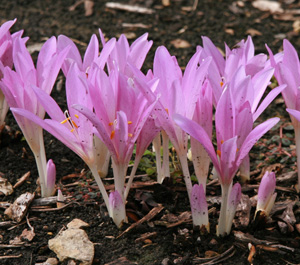
The word crocus usually conjures images of cheerful small flowers emerging from snow and ice as the first harbinger of spring. But there are a few species of the genus Crocus, part of the iris family (Iridaceae), that bloom in the fall and other fall-blooming bulbs that have the word crocus in their common name. In the U.S., the commonly called “Autumn Crocus” is not a true crocus at all but species or hybrids of Colchicum, a group of fall-flowering bulb in the lily family (Lilaceae). Other common names for these plants include meadow saffron, naked lady and colchicum. The genus has been used medicinally but because it is quite toxic when ingested, its use is not recommended except by professionals.
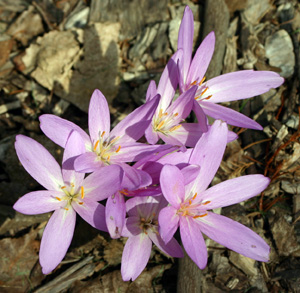
C. autumnale is one of the most commonly grown autumn crocus but other species, particularly C. speciosum, which is a parent of many of the showy hybrids, are also often available. The taxonomy of this genus is rather confused, and misnaming often occurs in the trade, so many of the so-called species in cultivation are actually hybrids of unknown origin. For example, C. bysantinum, with large corms that produce multiple flower stalks, is probably really a sterile hybrid of C. cilicicum, sometimes offered as C. autumnale ‘Major’. Although there are about 65 species worldwide, the few that are common in the ornamental industry are very similar in appearance and cultivation.
These Colchicum species should not be confused with the saffron crocus (Crocus sativus, also sometimes commonly called autumn crocus; it is only marginally hardy in Wisconsin) which is used as a spice and dye. These two are the most common commercially available fall “bulbs” and superficially resemble each other. C. autumnale or C. speciosum should definitely not be used in place of saffron in cooking because eating any part of this plant can be fatal.
Native to Europe and North Africa, C. autumnale grows wild in woods and damp meadows and has been naturalized in some parts of the US and Canada. It is hardy in zones 5-9 (maybe colder if given extra winter protection) and blooms in September in the Midwest.
The upright, 8-14″ leaves of autumn crocus resemble that of a short, dark green tulip or even a romaine lettuce head. Three to eight leaves grow out of a bulb-like corm in the spring and then go dormant in the early summer. The plants are not attractive as the leaves are dying back but like other bulbs, they need to be left until they dry out in order to supply nutrients to the bulb. Hardy geraniums or other spring or early summer-flowering perennials can camouflage the yellowing colchicum leaves, and then those plants can be sheared back in fall to let the colchicum flowers show.
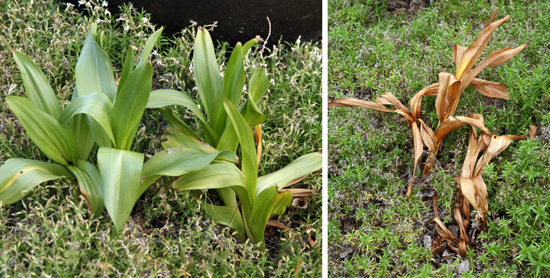
In early fall, the corms produce a bouquet of flowers, with 1 to 10 flower stalks from each bulb. Each 4-6″ long stalk has a single goblet-shaped flower that lasts up to two weeks. The 2″ wide flowers emerge from the ground long after the leaves have died back (hence the common name naked ladies). They are primarily a light pink-purple color but some cultivars have white flowers. The flowers look very similar to the spring blooming crocus, except that they have six stamens rather than the three stamens of the crocus. C. speciosum has large, fragrant, goblet-shaped flowers up to 5″ tall that have a white throat.
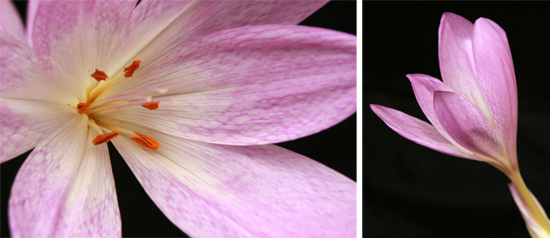
Autumn crocus needs to be planted in mid- to late summer in order to establish by fall for blooming.

This is long before most people consider planting bulbs, so this species has not been widely utilized in gardens. Plant the waxy, irregular corms covered in a dark-brown, leathery skin in well-drained soil about 6 inches apart. The corms are quite large and should be planted 3-6 inches deep.
Colchicums are well suited to growing under deciduous trees or shrubs, or mixed in with other perennials but will do best in full sun when in leaf. Colchicums prefer well-drained soil that doesn’t dry out in summer. Being drought tolerant, C. autumnale is ideal in rock or gravel gardens, where their flowers can be readily seen among the other low-growing plants. They also naturalize well under grass – although the turf cannot be mowed when they are in flower or leaf – and are very suitable for low meadows.

Or they can be interspersed among low groundcovers, such as bugleweed (Ajuga), creeping jenny (Lysimachia nummularia), creeping thyme, sedum, or Vinca minor, where the other plants help hold up the flowers that can be somewhat floppy. The pink-purple flowers contrast nicely with the silver leaves of lambs ear (Stachys byzantina), and combine well with purple asters, pink chrysanthemums, and plants with purple foliage. White-flowered cultivars are set off well by the dark foliaged cultivars of Ajuga, such as ‘Black Scallop’, ‘Chocolate Chip’ or ‘Mahogany’. They look best planted in clusters or scattered drifts of 5 or more bulbs and will naturalize under ideal conditions. If you need to move or want to divide the plants, do this in summer after the leaves have died back but before the flowers begin to appear. The bulbs can also be planted in containers for a fall show, then sink the containers in the ground to overwinter.
There are a number of named cultivars and hybrids of autumn crocus, including:
-
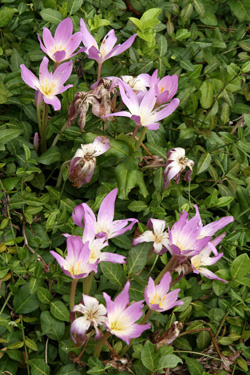
There are many cultivars of Colchicum.
‘Alboplenum’ – is a robust, sterile cultivar with double creamy white flowers. - ‘Album’ – is a weak growing, white-flowered form.
- ‘Autumn White’ – has white flowers.
- ‘Giant’ – is a free-flowering hybrid with very large flowers up to 10-12″ tall. The blooms are violet with a large white throat. Corms planted in early fall may bloom that season.
- ‘Lilac Wonder’ – a large hybrid with narrow, rosy-purple flowers with white midlines.
- ‘Pleniflorum’ – a double lilac-pink variety.
- ‘Violet Queen’ – a hybrid with violet flowers that have white lines in the throat and distinctive orange anthers.
- ‘Waterlily’ – one of the most commonly available, is a sterile hybrid with lilac-pink flowers with multiple petals (often 20) that resemble a waterlily flower. Its flowers often need support, such as from a low groundcover, to prevent them from falling over.
– Susan Mahr, University of Wisconsin – Madison





 Asters, Symphyotrichum spp.
Asters, Symphyotrichum spp. Fascinating Fasciation
Fascinating Fasciation Alternatives to Lawn: Groundcovers
Alternatives to Lawn: Groundcovers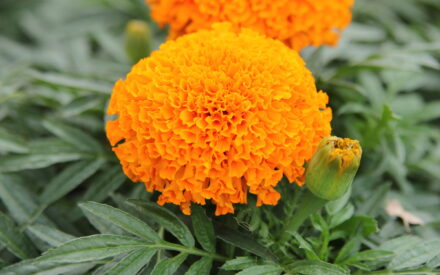 Marigolds
Marigolds


